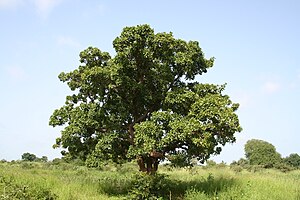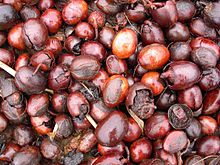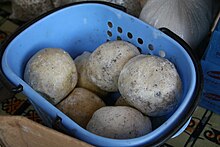Shea tree
| Shea tree | ||||||||||||
|---|---|---|---|---|---|---|---|---|---|---|---|---|

Shea tree |
||||||||||||
| Systematics | ||||||||||||
|
||||||||||||
| Scientific name of the genus | ||||||||||||
| Vitellaria | ||||||||||||
| CFGaertn. | ||||||||||||
| Scientific name of the species | ||||||||||||
| Vitellaria paradoxa | ||||||||||||
| CFGaertn. |
The shea tree , even Sheanussbaum , shea tree , shea or African butter tree called ( Vitellaria paradoxa , syn. : Bassia parkii G.Don ( parkii honors the British explorer Mungo Park ), Butyrospermum paradoxum ( CFGaertn. ) Hepper , Butyrospermum parkii (G.Don) Kotschy ), is the only plant species of the genus Vitellaria in the family of the sapotaceae .
description
Vegetative characteristics
Vitellaria paradoxa grows as a slow-growing tree that reaches heights of 15 to 25 meters, with a strong trunk and a branched, spreading tree crown . The very thick and rough, reticulated and corky bark is usually gray to blackish or reddish and can protect older trees from fire. The trees can be over 300 years old, the manhood is 10 to 25 years. There are short shoots formed with angular leaf traces. The bark of young twigs, petioles and flower buds has rust-colored hairs of varying thickness.
The dark green and underneath lighter leaves are arranged in a spiral at the branch ends. The petiole is about 5 to 10 cm long. The obovate, ovate or oblong to elliptical, leathery and almost bald leaf blade is 10 to 25 cm long and 4.5 to 14 cm wide. The nerve is light green with 20 to 30 alternately pinnate side nerves per half of the leaf and a thicker midrib. The leaf margin is whole and somewhat thickened and wavy. The leaves are shed at the beginning of the dry season. The small stipules are sloping.
The trunk, the branches and the fruits, seeds and the leaves have a reddish, gutta-percha-like milky sap , because here too the polyisoprenes , in contrast to natural latex , are mainly trans -configured (Kariten).
Generative characteristics
About 30 to 40 flowers or more (up to 100) stand together in dense clusters at the branch ends. The up to 3 cm long, hairy stalked flowers are fragrant and hermaphroditic and protogynous . The rust-brown and hairy, free sepals stand in two circles, usually in groups of four: the outer ones are egg-shaped, 9 to 14 mm long and 3.5 to 6 mm wide; the inner ones are a bit smaller. The six to eight cream-colored, roof-tile arranged petals are short tubular fused with 2.5 to 4 mm long corolla tube and broad-egg-shaped, 7 to 11 mm long and 4.5 to 7 mm wide corolla lobes. The usually six to eight free stamens are 7 to 12 mm long. The movable and eilanzettlichen anthers are up to 4.5 mm long. The usually six to eight larger, petaloid and pointed, fringed staminodes and the ovary are up to 8 mm long. The multilocular (up to 10), hairy ovary is upper constant, long mm with an 8 to 15, the preceding stylus with smaller, capitate, and crown-shaped scar. Pollination is done by insects or the wind .
The greenish to yellow or brownish, usually seeded (up to three), rounded at maturity, ellipsoidal to oval berries , have a length of up to 5 to 7 cm and a diameter of 3 to 5 cm. They contain a sweet fruit pulp that surrounds the seeds. The roundish, ellipsoidal to ovate, brownish and smooth, somewhat shiny seeds with a thin seed coat have a broad, rough hilum on one side . The seeds have a length of up to 5 cm and a diameter of up to 3.5 cm. They weigh about 5 to 16 grams.
Occurrence
Vitellaria paradoxa occurs in the savannas of the Sudan zone in tropical Africa between Senegal and Uganda . It grows at altitudes between 100 and 600 meters with an annual average temperature between 25 and 29 ° C and annual precipitation of 600 to 1400 mm.
Systematics
It was first described in 1807 by Karl Friedrich von Gärtner in Supplementum Carpologiae 131, t. 205. Numerous synonyms are known.
There are two subspecies:
- Vitellaria paradoxa subsp. paradoxa : It occurs from western tropical Africa to Ethiopia .
- Vitellaria paradoxa subsp. nilotica : It occurs from Sudan to Uganda .
use
From a botanical point of view , the fruits of the shea nut tree are berries , the roughly 4 cm large kernels contained in them, the shea nuts, contain around 50% fat and are an essential source of edible and skin-care fat ; the pulp is eaten.
According to the Food and Agriculture Organization FAO, 548,244 t of shea nuts were harvested worldwide in 2017. The largest producer by far was Nigeria, which with 361,017 tons brought in around two thirds of the world harvest. There were other notable harvests in Mali and Burkina Faso.
As an important crop tree, the shea, along with other species such as néré and baobab , is usually spared when clearing for new fields. This traditional agroforestry is also known as a cultural tree park . Since the shea tree is difficult to propagate, new plants are often just random germination, they only bloom from an age of around 20 years and only reach their full profitability at around 50 years of age, their large-scale commercial exploitation is due to the long waiting time for the Yield still difficult.
Shea butter
From the Kariténuss is vegetable fat that as shea butter, besides also won, shea butter , galam butter , shea butter or Bambukbutter is called. To produce this fat, the seeds of collected fruits are freed from the pulp, dried in various ways and chopped up. After separating the shell parts, the kernels are then heat-treated and grinded into a fatty mass. Lastly, water is added to this and it is time-consuming hand-worked to separate the fat from all undesirable components. The greasy, tallowy shea butter obtained in this way is almost white, slightly yellowish, ivory-colored or green-yellowish, its peculiar smell is described as fatty, aromatic, spicy and similar, depending on the variety, sometimes fruity, nutty, wooden or smoky components are perceived. The melting range of shea butter is 35 ° C to 42 ° C.
One variant is so-called “black shea butter”, which is obtained by roasting the nuts for 15–30 minutes. This fat is of an inhomogeneous grayish color and has an intense aromatic, smoky odor.
Shea butter can be kept for up to four years in its pure state, even in tropical heat. The special thing about the shea butter is the high proportion of unsaponifiable components (around 75% triterpenes, in addition oleic acid, triterpene alcohols, vitamin E , beta-carotene and allantoin ), the proportion is between 8 and 11% - compared to avocado oil 6%, sesame oil 1.5%, olive oil 1.2%. Shea butter mainly contains triglycerides of long-chain, unsaturated fatty acids . Acyl residues of oleic acid (40–55%), stearic acid (35–45%), linolenic acid (3–8%) and palmitic acid (3–7%) dominate among the fatty acid residues of triglycerides .
However , shea butter is often refined for export : the resulting fat is odorless, tough and white in color. The ingredient beta-carotene (yellow color) is lost in the process; further investigations into lost ingredients are not known.
Shea butter is used as cocoa butter equivalent for cocoa butter in chocolate production, and as an ingredient in organic stock cubes . “Black shea butter” is mainly used in the kitchen.
literature
- J.-M. Boffa: Productivity and management of agroforestry parklands in the Sudan zone of Burkina Faso, West Africa. Dissertation, Purdue University, West Lafayette, Indiana, 1995.
- EG Bonkoungou: Monographie du karité, Butyrospermum paradoxum (Gaertn. F.) Hepper, espèce agroforestière à usages multiples. Institut de Recherche en Biologie et Ecologie Tropicale, Ouagadougou, Burkina Faso, 1987.
- A. Chevalier: Les Sapotacées à graines oléagineuses et leur avenir en culture. In: Revue de Botanique Appliquée. 23 (257, 258, 259), 1943, pp. 97-159 online at persee.fr, accessed on May 3, 2017.
- M. Gakou, JE Force, WJ McLaughlin: Non-timber forest products in rural Mali: a study of villager use. In: Agroforestry Systems. 28, 1994, pp. 213-226, doi: 10.1007 / BF00704757 .
- S. Guinko, LJ Pasgo: Harvesting and marketing of edible products from local woody species in Zitenga, Burkina Faso. In: Unasylva. 43 (168), 1992, pp. 16-19.
- AN Henry, V. Chithra, NC Nair: Vitellaria vs. Butyrospermum (Sapotaceae). In: Taxon. 32, 1983, p. 286.
- G. Sallé, J. Boussim, A. Raynal-Roques, F. Brunck: Le karité, une richesse potential. Perspectives de research pour améliorer sa production. In: Bois et Forêts des Tropiques. 228, 1991, pp. 11-23.
- A. Zwarg, M. Schmidt, K. Hahn-Hadjali: The Schibutterbaum. In: Nature and Museum. 138 (9/10), 2008, p. 242.
- HAM van der Vossen, GS Mkamilo: Vegetable oils. (= Plant Resources of Tropical Africa. 14). Prota, 2007, ISBN 978-90-5782-191-2 , pp. 182-187.
Web links
- L'or des femmes (Women's gold) - Report on the harvest and the transformation of nuts into shea butter in Burkina near Cap sur le Monde (French).
- La filière féminine du karité - (The Karité Connection) - Shea butter has become an important raw material for the cosmetics industry at Érudit (French).
- Physicochemical and microbiological characteristics of optimized and traditional shea butters from Côte d'Ivoire. In: African Journal of Biochemistry Research. 1 (4), 2007, 41–47, (PDF; 99 kB), at Academic Journals, accessed on May 12, 2019.
- Vitellaria paradoxa in the endangered Red List species the IUCN 2006. Posted by: Makerere University Institute of Environment and Natural Resources, 1998. Retrieved on 11 May, 2006.
- Vitellaria paradoxa . In: U. Brunken, M. Schmidt, S. Dressler, T. Janssen, A. Thiombiano, G. Zizka: West African plants - A Photo Guide. Senckenberg Research Institute, Frankfurt am Main 2008.
- Vitellaria paradoxa at Useful Tropical Plants.
Individual evidence
- ↑ Vitellaria paradoxa in the Germplasm Resources Information Network (GRIN), USDA , ARS , National Genetic Resources Program. National Germplasm Resources Laboratory, Beltsville, Maryland.
- ↑ a b Datasheet of the AgroForestryTree Database.
- ^ Frances EM Booth, GE Wickens: Non-timber Uses of Selected Arid Zone Trees and Shrubs in Africa. FAO Conservation Guide 19, FAO, 1988, 1993, ISBN 92-5-102745-5 , pp. 34-45.
- ^ Jules Janick, Robert E. Paull: The Encyclopedia of Fruit and Nuts. CABI, 2008, ISBN 978-0-85199-638-7 , p. 846.
- ^ Geoff Talbot: Specialty Oils and Fats in Food and Nutrition. Woodhead, 2015, ISBN 978-1-78242-376-8 , p. 142.
- ↑ RAS Hemat: Principles of Orthomolecularism. Urotext, 2004, ISBN 1-903737-05-2 , p. 160.
- ^ Rainer Höfer: Sustainable Solutions for Modern Economies. RSC Pub., 2009, ISBN 978-1-84755-905-0 , p. 205.
- ^ JH Hemsley: Vitellaria paradoxa in Flora of Tropical East Africa , 1968, online at JSTOR.
- ↑ a b c d Rafaël Govaerts (Ed.): Vitellaria paradoxa. In: World Checklist of Selected Plant Families (WCSP) - The Board of Trustees of the Royal Botanic Gardens, Kew . Retrieved June 4, 2020.
- ↑ Vitellaria paradoxa at KEW Science.
- ↑ Crops> Karite nuts (sheanuts). In: FAO production statistics for 2017. fao.org, accessed on March 15, 2019 .
- ↑ a b Sabine Krist: Lexicon of vegetable fats and oils . 2nd Edition. Springer, Vienna 2013, ISBN 978-3-7091-1005-8 , pp. 741 , doi : 10.1007 / 978-3-7091-1005-8 ( limited preview in Google Book search).
- ↑ Waldemar Ternes , Alfred Täufel, Lieselotte Tunger, Martin Zobel (eds.): Food Lexicon . 4th, comprehensively revised edition. Behr, Hamburg 2005, ISBN 3-89947-165-2 , pp. 1721 .
- ↑ R.-M. Megnanou, S. Niamke, J. Diopoh: Physochemical and microbiological characteristics of optimized and traditional shea butters from Côte d'Ivoire ( Memento of the original dated December 20, 2007 in the Internet Archive ) Info: The archive link was inserted automatically and has not yet been checked. Please check the original and archive link according to the instructions and then remove this notice. (PDF; 101 kB).
- ↑ S. Ellsässer: Toiletries and cosmetics: A textbook for PTA training and advice in pharmacy practice. Springer, 2000, ISBN 3-540-66866-7 , p. 141.





